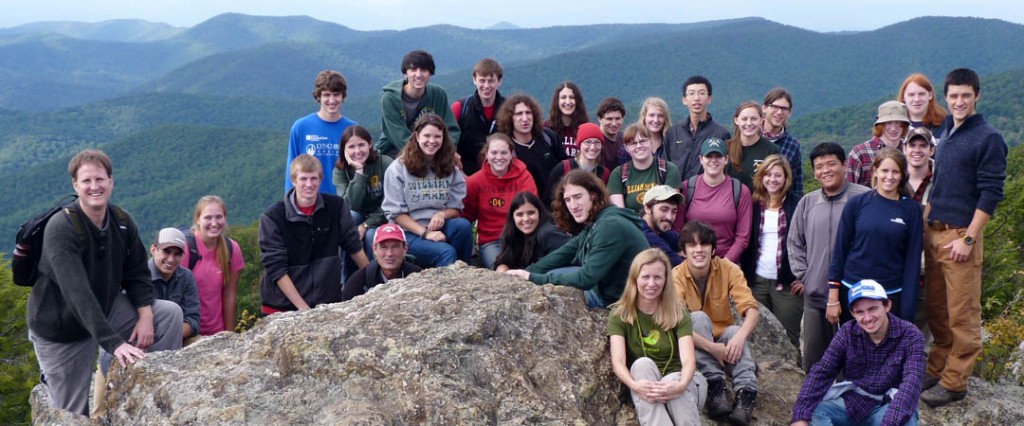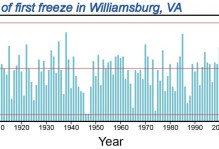Mountain Mayhem
As I’ve noted in these posts before, Geology Departmental field trips are unique as they bring together the W&M geologic community in a way that staying on campus never could. The Fall Field trip took an enthusiastic crew of students and faculty to the Blue Ridge Mountains for a weekend getaway. Our timing was just right as an on-shore flow of moist air brought rain and a dreary Saturday to Williamsburg. The mountain mayhem began at Big Meadows in Shenandoah National Park. We savored the irony that Big Meadows, one of Virginia’s wettest locales with a yearly precipitation average of 130 cm (50”) per year, was dry while Williamsburg was wet.
Professors Greg Hancock and Jim Kaste got the discussion started as we pondered the flattish landscape of Big Meadows, and hiked into Hogcamp Branch to consider stream dynamics and the role that bedrock plays in water chemistry. The ascent of Bearfence Mountain took us from the basement complex (always my favorite), up through outcrops of sandstone in the Swift Run Formation, to a rocky spine of greenstone exposed along the crest of the ridge. At Rockytop Overlook we basked in late afternoon sunbeams. The scene was so sublime that some faculty broke into song, songs extolling the virtues of steep slopes and rocky tops. We made camp in the twilight, devoured bowls of chili, and reveled by the fire long into the evening.
To get a better sense of the mayhem- Check out video snippets from the field trip
On Sunday morning we shook off the dew and began with a jaunt along the Appalachian Trail to exposures of sandstones, conglomerates, and siltstones in the Weverton Formation—its depositional environment, way back in the early Cambrian period (~540 million years ago), was vigorously debated. Another hike took us to Calvary Rocks, where well-cemented quartz sandstones of the Antietam Formation revealed their secrets. Our last debate focused on the landscape—are the Blue Ridge Mountains growing, shrinking, or in some long-term steady-state? Any thoughts? (comments welcomed)
Our weekend excursion to the Blue Ridge was uplifting (pun intended!). For an old mountain range the Blue Ridge is more dynamic than you might think.
Comments are currently closed. Comments are closed on all posts older than one year, and for those in our archive.







I have to believe those old mountains are in fact shrinking. Erosion will continue to take its toll, and I see no modern tectonic forces that can lead to growth. Even with crustal buoyancy possibly leading to some additional uplift, the long-term trend is one of decline. This is admittedly a non-expert opinion; I look forward to hearing another view.
I think I’m going to go with growing. So if the peaks are mostly, let’s say greenstones and sandstones, and the valley floor around the mountains are less resistant carbonate rocks, couldn’t the valley be eroding faster than the peaks are? That would increase relief anyway- not sure if that’s technically growing (you never specified absolute elevation or relative to the valley).
At the risk of looking foolish, I think I’ll wander down the isostasy path, too, while I’m at it. Might it all come down a war between isostatic uplift and erosion? So let’s say you make ~80% of your elevation loss from erosion back with isostatic rebound, then you’re only actually losing ~20% of the elevation that you would otherwise lose. I don’t know much about Blue Ridge glaciation, but if there were any alpine glaciers there that are gone now, there could be rebound happening there, too. So as long as that ‘outweighs’ what’s left of our debits from erosion- you could have a situation where the mountains are growing. Hey Chuck- were there any Pleistocene glaciers as far south as Big Meadows?
Also, Molly, I apologize sincerely for abusing commas in this post.
I’m not sure about the specific case of the Blue Ridge, but on the peaks there doesn’t have to be a war. As the isostatic rebound is caused by the removal of weight at the surface, like Chelsea said, the surface elevation rebounds by ~80% of the height removed. But the highest points are not only benefiting from the rebound due to erosion of the peaks, but also the isostatic rebound due to erosion of the valleys.
So if the majority of erosion occurs in the valley, isostatic rebound due to erosion could actually be uplifting the peaks, hows that for counter intuitive!
The question is moot. It is all a matter of perspective. Relief, as defined as total difference in elevation, is increasing as stream-bed erosion in the valley is incising whilst the mountains themselves are at a relatively steady state as isostatic rebound is for the most part compensating for the majority of the erosive activities occurring on the mountains.
Relief, as defined as the sharpness in the change in elevation, is actually lessening as the mountains become more rounded and thus sharp changes in relief are becoming muted over time.
Total elevation is certainly lessening, an assertion that needs no explanation.
And Chelsea have you not seen the glacial dropstones in the Rockfish Conglomerate!
Though with the reactivation of paleo-faults in Mineral, VA and all, you could have a different answer entirely!
Another perspective to consider: The erosion of the topography in certain areas may be more lateral than vertical. In the case of the Blue Ridge escarpment in soutwest Virginia and western North Carolina, for example, the asymmetrical divide appears to be retreating westward at a geologically rapid pace, possibly due to fluvial erosion and drainage basin capture by streams. Overall, the continued retreat of the escarpment long after faulting has occured suggests that the topography is not in steady state.
Isostasy and lateral erosion are all well and good (and scientifically proven–I put myself on the “growing” side for reasons already described), but one thing that might seem “less interesting” to you geologists is that regardless of what the answer is, those with power who make important decisions are not fully aware of exactly how active the Appalachians are.
In fact, a Geo 101 student (which I once was) learns about the formation of the Appalachians (the African and N. American tectonic plates colliding a long time ago with lots of softer rocks folding over harder varieties around 250 million years) and little else. The assumption they are left with is that, well, they were formed and now they just sit there. Cool.
If I didn’t take Surface, I wouldn’t have even known about isostasy or exactly why the peaks of mountains themselves don’t erode as fast as the valleys do. Thus, what I am suggesting is that scientists need to better communicate to the general public (and especially our elected officials) exactly how this matters in our society. Will a lower total elevation affect the climate of the Virginia or North Carolina Piedmont? What about species of trees? And the health of our rivers with all of this calcitic erosion from the likes of limestone?
Or, does it matter at all? Clearly it will have some impact on the people of the Blue Ridge. The issue is, however, that its effects are not immediately sniffed out; things like isostasy aren’t readily noticed because they are long-term trends. Time scale is critical to this issue, and unless Afton Mtn. becomes Mt. Everest tomorrow or the mighty James becomes completely choked with silt the day after that, the likely response to your original question, Chuck, is that the mountains are very steady.
I think the Blue Ridge Mountains are in a steady state, due to the balancing of erosive processes on the landscape and the lifting of the mountains due to isostatic rebound. I could be wrong though; the erosive processes could have a major impact on the blue ridge mountain range and could indeed be the dominant process, which would mean that the blue ridge mountains would be decreasing in elevation.
If anything, I’m pretty sure that the mountain range is not “growing”, because the Blue Ridge formed when the East coast of the US was an active margin, which is not the case anymore and therefore no material can be accreted onto the mountain range to cause growth.
The biggest point to keep in mind with this question is scale, not only temporally but spatially as well. If you ask most non-geologists, they would probably tell you that the Blue Ridge mountains are just relics of past mountain-building episodes, which is true. They are unaware, however, of the activity happening now because, in our fast-paced society, this kind of long-term movement goes unnoticed.
Spatially, I think it’s important to note that the glacial ice sheet covered most of the Blue Ridge, and so this rebound is likely occurring at the same rate throughout the area. On the other hand, erosion depends on more local factors like vegetation, the composition of the rock, the stream systems, etc. You could have a situation where the isostatic rebound is dominant in some areas, thereby “growing” the relief, and in other cases erosion where conditions are right and supersedes the isostatic rebound.
I know this sounds like a cop-out answer, but this question has too many details to just have a simple one-word answer. I’m sure Chuck and the gang know this, ha.
When you say “long-term” steady state, how long did you mean? Even though erosion rates in the valley and on the top of the mountains may not be exactly in sync at this time, over a longer period they may level out. Or they may continue to diverge. Only time will tell!
Phillip brings up the interesting point of the Blue Ridge Escarpment, which runs from Virginia to Tennessee. For this portion of the Blue Ridge at least, it is retreating. The Escarpment has the Blue Ridge plateau on its western side with a relatively steep slope down to the Piedmont. The Escarpment is retreating west, most likely due to drainage basin capture from the plateau.
Another thing to think about is that erosion is a constant force on mountains this old. These mountains were formed during the Taconic Orogeny (Ordovician Period), and have had over 400 million years to shrink down to the size they are today. This is now a passive margin, so they aren’t growing due to that geologic process any more. Though they may be “bouncing back” due to isostatic rebound responding to the erosion. We actually read a paper in Surface about this: how erosion can actually cause a mountain to grow. It sounds wacky, but it’s been studied extensively. Based on all this, I’d say that perhaps the isostasy and erosion balance out to some semblance of steady state, or that maybe they will be shrinking more than growing (following the observation that they are much smaller than they were in the past).
A lot of you are mentioning isostatic uplift/buoyancy. For us non-science folks out here, can someone explain what that is? Is it that a plate is pushing into another causing one to rise up in response to the pressure? So the mountain then rises and “grows?” I’m not sure I quite understand. Perhaps you can shed some light on this Chuck.
Having taken all but 2 geology courses so far, the extent of my knowledge would lead me to believe that the Blue Ridge Mountains are quite obviously shrinking. They’ve eroded from what used to be a grand chain of mountains nearly 1 billion years ago (the Grenville orogeny). I am pretty confident that the mountains are not growing (seeing as they’ve slowly eroded as they’ve moved westward from Richmond) but from what I’ve read about talk of isostatic rebound, they may stay at their status quo. Of course, as Jamison brought up, it is important to keep everything in scale. Over a geologic time scale, the mountains are eroding away, but in a much smaller window of time the mountains could be growing or shrinking slightly depending on a positive or negative net deposition rate due to isostatic rebound.
If isostatic rebound is a result of huge ice sheets weighing down on the surface, shouldn’t the rebound process slow over time? If this is true (I’m no expert) then I would think that the erosion process will have a greater impact on the elevation as it slowly rounds down the peaks. Therefore, I would expect that the blue ridge mountains are shrinking.
I have to put myself in the shrinking camp, too. Everything I’ve seen attributes major episodes Blue Ridge growth to tectonic events unlike those that are currently occurring in the Mid-Atlantic Ridge system.
Also, most of what I’ve seen about isostatic rebounding pertains to the movement of ice. While the last glacial maximum may have brought glaciers into the Adirondacks in New York and other places along the Appalachians, I don’t believe that they reached as far as the Blue Ridge. In that case, isostatic rebounding due to simple wind/rain erosion of the existing mountains would be having far less of an impact than what is being seen in other, more northern locales.
I’m going to tackle the question of ‘shrinking’ in a basic sense – the relief of the blue ridge from a peak directly straight down through the mountain to sea level. Using sea level as a basis for height allows us to track the changes in relief through time.
So, my vote is that the Blue ridge mountains are shrinking. The tops are getting eroded faster than the rest of the mountain. As for the isostasy argument you’re forgetting about flexure. It also plays a role in the expansion and contraction of the Earth’s layers. The crust supports some of it’s own weight, for example the erosion off the earth’s mountains.
Though I am not a geology major and cannot claim to know as much as everyone else on this blog so far, I would have to throw myself into the ‘shrinking camp’. The amount of erosion occurring would be larger than any other method of formation currently operating in the Blue Ridge Mountains.
I also agree with Samantha in saying that, if anything, it most likely is not ‘growing’, since the East Coast area is not active and the uplifting of rocks that forms mountains is not occurring, at least at a rate that would counteract erosion and other ‘shrinking’ methods.
I also believe the Blue Ridge Mountains are shrinking. These mountains were formed more than 500 million years ago due to rock folding, rock faulting, upward thrusting, and continental collision. However, I believe, due to erosion and weathering, the mountain range is shrinking at a faster rate than it is growing. To get a better sense of the current state of the Blue Ridge Mountains, you all should check out Dolly Parton’s song “My Blue Ridge Mountain Boy.”
If isostatic rebound is no longer occurring in the region, the mountain range should be experiencing an overall lowering in elevation throughout time (relative to sea-level). The relief, however, continues to increase as erosional processes happen at a faster rate around hillsides, below ridge lines. Deeper incision to the valley floors via alluvial processes increases the relative relief in the Blue Ridge.
It seems that everyone so far has discussed isostatic rebound due to the melting of glaciers in a sense that it would be compensating for, through uplift, the erosive processes that are acting on the mountains. But I was under the impression that most of the Blue Ridge Mountains, including those in Virginia, were not glaciated during the Last Glacial Maximum. The weight of glaciers depresses the land that is covered by them, but this depression may also cause the land surrounding the glacial coverage to buckle and uplift. Is it possible that isostatic rebound due to glaciation is causing land near glaciated areas, including parts of the Blue Ridge Mountains, to actually subside in response to the removed weight of the receding glaciers? In this case, isostatic rebound would actually be a factor contributing to the shrinking of the Blue Ridge Mountain relief.
It seems that everyone so far has discussed isostatic rebound due to glacial recession in a sense that it would be compensating for, through uplift, the erosive processes that are acting on the mountains. But I was under the impression that most of the Blue Ridge Mountains, including those in Virginia, were not glaciated during the Last Glacial Maximum. The weight of glaciers depresses the land that is covered by them, but this depression may also cause the land surrounding the glacial coverage to buckle and uplift. Is it possible that isostatic rebound due to glaciation is causing land near glaciated areas, including parts of the Blue Ridge Mountains, to actually subside in response to the removed weight of the receding glaciers? In this case, isostatic rebound would actually be a factor contributing to the shrinking of the Blue Ridge Mountain relief.
I think the Blue Ridge Mountains are probably shrinking. Because there isn’t much, if any, tectonic activity in the east coast area, there aren’t a lot of factors that could cause growing that would be enough to counter the level of erosion. The isostasy argument is worth looking into to see exactly how much of an effect it might have, but I still think any effect would not be greater that the effect of erosion. Therefore, Blue Ridge Mountains are probably shrinking.
I’m posit that the Blue Ridge are somewhat stable, but if anything are shrinking slightly. The orogeny that produced this once mammoth mountains has long since passed and forces of erosion, both natural and man made, have taken their toll on the landscape. I believe that there is little uplift occurring from the once active boundary that caused these mountains but also, they are quite a bit shorter than they once were. They do not cause as drastic an effect of rainshadow as they once did and thus erosion due to the large relief of the mountains is less of an issue. My conclusion is that although minor, there is a decrease in the elevation of these mountains due to erosion.
Also, nice youtube video.
I would guess that the Blue Ridge Mountains are in some sort of long-term steady-state equilibrium. One obvious comment would be that erosion will continue to play a role in this system. Erosion from wind, rain, rivers, anthropogenic, etc. However, while orogenic processes are likely to be ceased, isostasy can and may be in play, in which relative sea level could be lowering if the crust beneath the mountains is rising.
The theory of isostatic rebound may go the other way, though. I remember learning in a marine science field course that the melting of glaciers on North America has been causing isostatic rebound to occur on the continent; however, as weight from the glaciers is removed from the northern latitudes of North America via melting, the land beneath the glaciers are rising. Therefore, as the northern half of the continent rises, then (like a see-saw) the southern half of the continent would sink. If this is truly the case, then the Blue Ridges may be “shrinking” if you are regarding its relative height. But isostatic sinking may not necessarily mean that the mountains themselves are reducing in size/mass/volume/etc.
While I agree with the potential problems of “growing or shrinking relative to what?”, I think I still have to go with shrinking. The mountains are very old, and have decreased overall in size over time. I think the mountains are probably eroding more than isostatic rebound is making up for, which would result in overall shrinking. Although, I could also see that maybe the rebound and erosion are mostly evening out, resulting in a steady-state situation.
Edit: I meant to say “I posit” not “I’m posit”.
Thus far, we seem to have reached the consensus that the two dominant processes contributing to change in elevation of the Blue Ridge are erosion and isostatic rebound. My question (to which I don’t have an immediate answer) concerns the rate at which these processes are taking place. How quickly can rebound occur, and how does that compare to local erosion rates? Is it possible that directional change (dominantly controlled by either erosion or rebound) in the Blue Ridge may vary through time?
I believe that erosion seems to be the “winning” factor in this case. I do think that isostasy does come into play, but erosion is constantly taking place. Though tectonic activity may cause the mountains to grow along a certain boundary or fault, I think in the long run, the mountains will be eroded back in size. The effects of erosion are clearly visible in the Blue Ridge mountains today with their low-profile, rolling structures. Summer thunderstorms, constant winds, freezing rock slides during the winter time are year-round forces that can change the face of a mountain almost overnight if violent enough. Thus, although there are a lot of forces at work here, I think erosion is the strongest, quickest, and most influential in the molding of the Blue Ridge mountains.
Through my limited knowledge of the subject, I’d say that the relief is increasing. People have already made points about the relative hardness of the rocks on the ridges in relation to the valley carbonates. It seems like this would cause the valley to erode more quickly than the ridges. In addition, any erosion along the hillsides would not change the elevation of the highest points on the ridge, so I’m not sure that slope would have too significant of an effect. I would also guess that there is more significant fluvial activity in the valley in terms of ability to carry larger sediment loads.
Seeing as I am not a Geo major, I don’t really have much (if any!) knowledge on this topic. However, I am inclined to think that the Blue Ridge Mountains are probably shrinking. I feel like the rate of erosion, whether through natural or human causes, is much faster than the rate of tectonic growth. I also wonder whether tectonic growth even occurs; as Samantha pointed out, the East Coast is not an active area, so could there be any uplifting that would contribute to mountain growth?
I am thinking that the Blue Ridge is most likely shrinking. While there is no major tectonic activity, and there has been some isostatic rebound, erosional processes would most likely be far more consistent and a greater presence in the region.
If, as evidence suggests, no more isostatic rebound is currently happening, one would expect an elevation decrease (measured from sea level) of the mountains. Erosion should hasten at lower elevations causing the overall relief of the mountains to increase. These erosional processes are most likely the dominant force in the region, but the overall elevation of the Blue Ridge is generally decreasing while the relief increases.
Wow, I am impressed by the geologic knowledge of all my classmates! I know little geology, and so my attempted answer to Chuck’s question is very simple. The Blue Ridge Mountains are not being actively uplifted and so their elevation above sea level is decreasing with erosional processes. Sea level is also rising, and so their elevation above sea level is decreasing in two different ways.
I agree with Jamison (on Oct.14), at least his final paragraph. As a non-geology major, I don’t feel informed enough to say what the mountains are doing long term, but it seems obvious to the average person that for all practical purposes the mountains are in a relatively steady state.
I’ve certainly learned something here, including some pretty impressive geology vocabulary. I was wondering what this question could possibly have to do with weather or climate, but based on all the discussion of erosion and effects of melting glaciers, there does seem to be a pretty neat connection.
Wow, this has been a great geology refresher for me! It is hard to know what to call it as mentioned above, because uplift from isostatic processes is constantly being “complemented” with erosion, as an ongoing process. Can you call this a long- term steady- state? I’m going to say yes even though I do not think they will look the same millions of years from now.
With the Blue Ridge Mountains being apart of the ancient Appalachian Mountain range which was formed by the accretion of several orogenies due to early plate tectonics, it seems as though, it is easy to answer the question with their shrinking. The Appalachians have been mentioned as once being the size of the Himalayas in several classes and texts, I’ve encountered here on campus. Obviously, they are not in this state anymore as erosion has taken its toll over years upon years of rainfall and wind. But, as many previous posters have mentioned, isostatic rebound is a process to consider. The rebound in which the mountains see an increase in elevation from the relief of pressure caused a glacier that once resided over the mountain range, seems unlikely to have an affect over the consistent erosion the mountains have been encountering for millions of years. My reason for believing this is that the glacier cover in this area during the ice age was not as heavy as most areas north of the Blue Ridge Mountains. Also, when looking at the big picture, the mountains have shrunk since, their glory days of Himalaya-status peaks. There may be a blip in the decreasing trend in elevation from isostatic rebound, but overall I believe the mountains will continue to shrink.
As with several others on here, I am not a geology major or minor, and thus have little geologic theory to back me up; however, from the little I know/remember/can piece together, I think the Blue Ridge Mountains must be shrinking, if at a fairly slow rate. There don’t seem to be many, if any, active mountain-building processes in the area. Yes, the earthquake in August indicates some active fault lines in the Virginia region, but it was such a rare occurrence and huge deal that it seems unlikely such a fault would result in large enough forces to build a mountain. The mountains also generally seem more rounded and less jagged, steep, and pointy than the Rocky Mountains or other impressive mountain ranges, which I assume can be attributed to erosion over the millions of years since their formation. So while the mountains don’t seem to be going anywhere terribly quickly, I am joining the “shrinking camp” in saying that the mountains are slowly being worn down by erosion (and possibly other, more sophisticated geologic forces).
I’m also going to have to throw my hat into the “shrinking” camp. The argument of isotatic rebound, while persuasive and likely to be a factor, does not seem to be as strong of that of erosion and other shrinking factors. While the rebound likely provides a significant uplift, erosion seems to be a stronger effect.
However, I would like to know more about the role of erosion in shaping the Blue Ridge Mountains. What plays a greater role in erosion? Is more lost through small-scale weathering of sediment by wind, water, gravity, or other factors? Or do the large-scale, cataclysmic landslides, mudslides, massive flooding, or the breaking of gigantic boulders which cascade down the hillside detract more from the overall height of the mountains? How long do these events take place over? These are the important questions!
I recall us discussing this very question towards the end of our departmental field trip this semester. I believe that our group came to the conclusion that the relief from the peak of the mountain to the valley floor was increasing at some ridiculously slow number. It was around six meters every million years. Meaning this: The mountain peaks which are made up of rocks that are more resistant to weathering will withstand the erosion better than the valley rocks.
As a W&M Geology Alum I am proud to see so much thoughtful discussion on this topic. As a scientist, former teacher and citizen I especially like Jamison’s comment about establishing the societal relevance of scientific queries. In addition –this may be cheating to help you current students but here goes– I wanted you to be aware of the two informative articles.
This first article may provide you with some insights about the extent of ice in Virginia.
Bailey, C. M. and Peters, S. E. 1998. Glaciogenic sedimentation in the Late Neoproterozoic Mechum River Formation, Virginia. Geology, v. 27, p. 623-626. (Related Science News Cover Article)
The next addresses the use in a previous post of the term “Afton Mtn”. The verdict on existence is:
Santa Claus, Easter Bunny, Tooth Fairy- check;
the Great Pumpkin- jury still out;
Afton Mountain- not so much.
http://web.wm.edu/geology/virginia/field_loc/rfgweb.pdf
I am hopeful that I will still get extra credit for this post.
I also believe the Blue Ridge Mountains are shrinking. I argue erosion from snow and runoff affects the mountains much more than tectonic activity. Obviously, erosion results in a breaking/wearing down of parts of the mountain. Besides the earthquake we experienced in August, the East Coast rarely experiences major tectonic activity which is what could cause plates to push together, causing the mountain to rise.